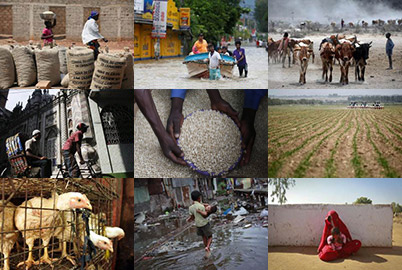Auditors give massive vote of no confidence in disaster relief body, though India is one of world's most disaster-prone countries
NEW DELHI (Thomson Reuters Foundation) - India's disaster relief agency suffers from "critical gaps" in its preparedness for calamities, making it largely ineffective when responding to the numerous disasters the country faces such as floods and earthquakes, a government auditor’s report has said.
The National Disaster Management Authority (NDMA) - set up in 2006 and chaired by Prime Minister Manmohan Singh - has neither information nor control over response to disasters and has failed to implement projects to strengthen the country's resilience, according a report by the Comptroller and Auditor General (CAG).
"In this audit, we found that despite considerable progress in setting up institutions and creating funding arrangements, there are critical gaps in the preparedness level for various disasters," the CAG report said.
"The National Disaster Management Authority, which was conceived as the apex planning and supervising body, was found ineffective in its functioning in most of the core areas."
India is one of the most disaster-prone countries in the world, with a bulging population of 1.2 billion, many living in areas vulnerable to natural hazards such as floods, cyclones, droughts and earthquakes.
Around 76 percent of India's coastline is prone to cyclones and tsunamis, while 59 percent of the country is vulnerable to earthquakes, 10 percent to floods and river erosion and 68 percent to droughts.
UNPREPARED PREPAREDNESS
Since 2001, the country has been jolted by around seven severe earthquakes which have killed some 25,000 people in states ranging from Gujarat in the west to Kashmir in the north.
Floods are an annual occurrence in parts of the northeast, disrupting the lives of millions. In 2008, a river in the eastern state of Bihar broke a barrage in neighbouring Nepal and changed course, unleashing huge waves and killing more than 500 people.
Experts say climate change and the increased risk of manmade disasters such as chemical and nuclear calamities, have led to a growing recognition of the need for better policies to help strengthen vulnerable populations around the world.
But, six years after the NDMA was set up, it has not only failed to finalise a national disaster management plan, but has also not succeeded in completing key projects, the CAG said.
"NDMA's project management capacity was deficient. As a result, none of its mitigation and vulnerability mapping projects was completed," said the CAG report, which is based on findings across nine states from 2007/8 to 2011/12.
These included hazard mapping for floods, landslides and earthquakes, rolling out a national school safety programme, establishing a mobile system for detecting radiation and building a nationwide disaster communication network.
MORE CONFUSION THAN SUPPORT
The audit also criticised the NDMA's response to various calamities, saying that communication between government agencies, the capacity of search and rescue teams and timely disbursement of funds for relief were all inadequate.
The report cited the response to the 6.9 magnitude earthquake which stuck India's Himalayan state of Sikkim in September 2011, indicating the lack of training and resources of rescue teams known as the National Disaster Response Force (NDRF).
NDRF teams were sent to the disaster zone without identifying the extent of the damage and the areas for deployment, causing confusion, the report said.
The teams were not self-contained and did not have enough food, water and shelter, or even clearance for movement of vehicles, placing a burden on army, police and administration staff who were already busy with rescue work.
"The reaction of the NDRF was an essential element of our tests. We noted that it was not yet established as a well equipped, well trained specialised force," said the report.
"Further, we noted that the deficiencies in this regard were not recognised and remedied, especially in terms of deployment or suitable manpower, equipment and training."
Our Standards: The Thomson Reuters Trust Principles.

